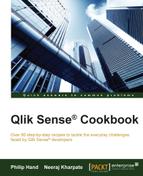Book Description
Over 80 step-by-step recipes to tackle the everyday challenges faced by Qlik Sense® developers
About This Book
- Create dynamic dashboards for business intelligence
- Discover the techniques and practices for Qlik Sense®
- Delve into a broad range of topics covering the Qlik Sense® backend and the all-important user interface
Who This Book Is For
The book is for everybody who have been exposed to Qlik Sense® and want to start using it actively for business intelligence. Anybody with prior knowledge of its sister product, QlikView, will also benefit from this book. Familiarity with the basics of business intelligence is a prerequisite.
What You Will Learn
- Source, load, preview, and distribute your organization's information
- Maximize the effect of visualizations for different types of data
- Get to grips with the new visualization functions and add bespoke features not covered in the standard options
- Leverage scripting tools, techniques, and best practices that once implemented, never stop adding value
- Make your user interface more advanced and intuitive with various custom objects and indicators
- Explore various tips and tricks of navigation for the Qlik Sense® frontend
- Develop creative extensions for your Qlik Sense® dashboard
In Detail
This book is an excellent guide for all aspiring Qlik Sense® developers. It will take you through the basics, right through to the use of more advanced functions. With the recipes in this book, you will be empowered to create fully featured desktop applications in Qlik Sense®.
Starting with a quick refresher on obtaining data from data files and databases, this book moves on to the more refined features of Qlik Sense®, including visualization, scripting, and set analysis. The tips and tricks provided will help you to overcome challenging situations while developing your applications in Qlik Sense®. This and more will help you to deliver engaging dashboards and reports efficiently.
By the end of the book, you will be an expert user of Qlik Sense® and will be able to use its features effectively for business intelligence in an enterprise environment.
Style and approach
This book is the perfect mix of essential theory combined with real-life examples, with clear explanations of sophisticated Qlik Sense® concepts. Each recipe begins with a task-based problem and the answers are provided in simple steps. This book follows an intuitive problem and solution approach that is easy to follow.
